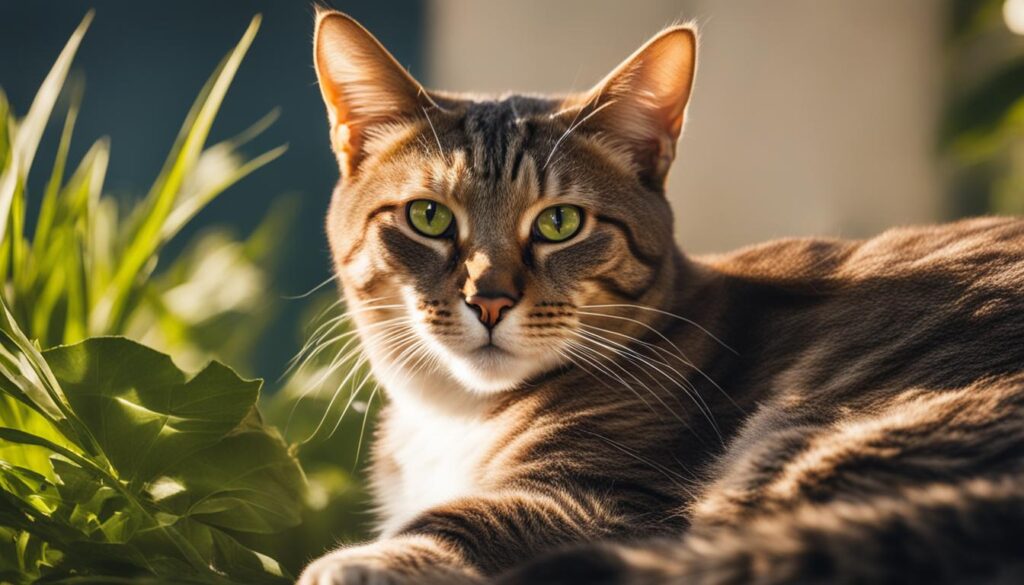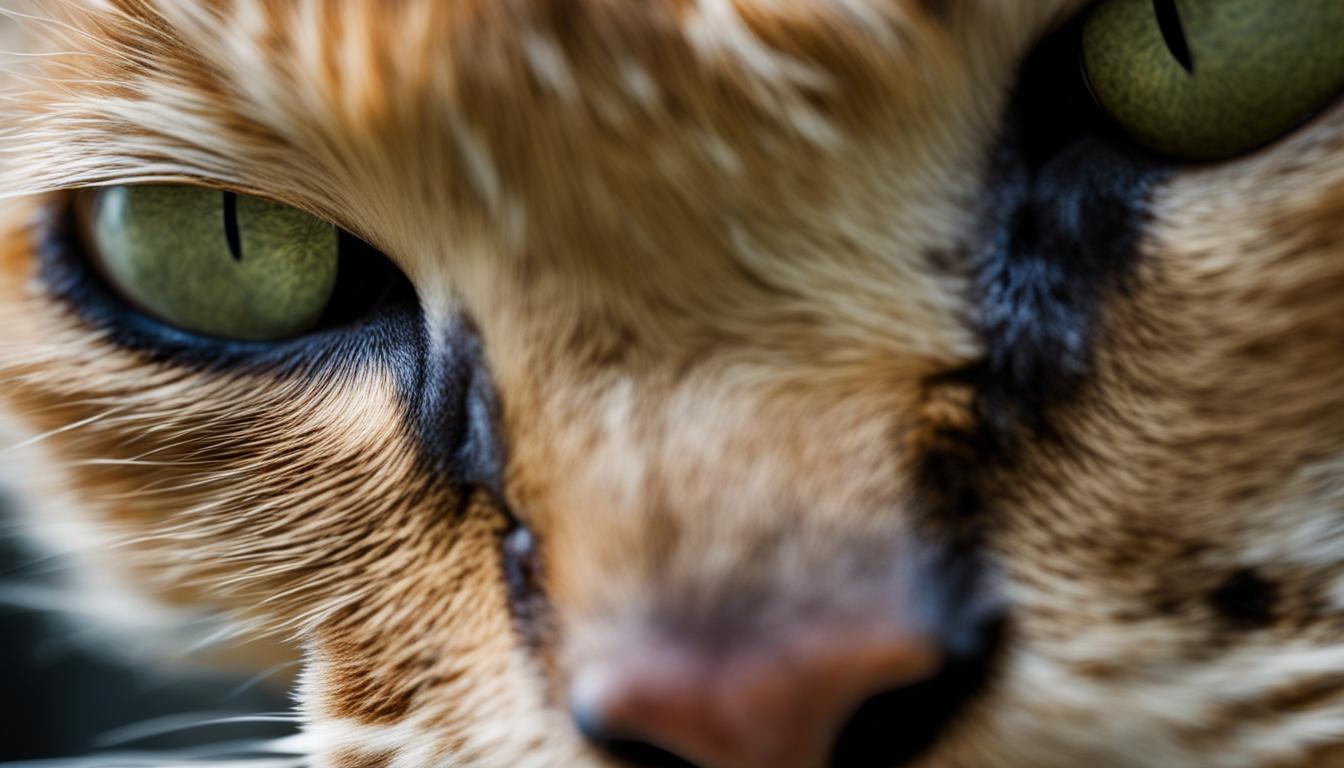As a feline enthusiast, I’ve always been curious about the fascinating world of cat skin conditions. From itching and scratching to redness and hair loss, these conditions can be a source of discomfort for our furry friends. But what exactly causes these skin issues, and how can we effectively treat them?
It turns out that biological factors play a significant role in the development of common cat skin conditions. Understanding these underlying causes is crucial in providing the right treatments and promoting the healing process. By delving into the science behind these conditions, we can better care for our cats’ skin health.
Key Takeaways:
- Common cat skin conditions are often caused by biological factors.
- Understanding the causes helps in providing effective treatments.
- Proper care can promote healing and alleviate symptoms.
- Regular veterinary check-ups and a balanced diet contribute to overall skin health.
- Treating cat skin conditions requires a tailored approach based on the specific condition.
Understanding the Importance of History and Clinical Signs
When it comes to diagnosing cat skin conditions, obtaining a thorough history is a crucial first step. By gathering information about the cat’s breed, age, sex, and neuter status, veterinarians can begin to identify potential differential diagnoses. However, history-taking goes beyond basic demographics.
Assessing factors such as pruritus level (itching), ectoparasite control, environment, diet, progression and response to therapy, and the presence of other affected animals or humans can provide valuable insights. These details can help veterinarians make more accurate diagnoses and determine the most appropriate treatment plan for each individual cat.
In addition to history, clinical signs and the distribution of lesions play a vital role in identifying specific skin conditions. The appearance and location of rashes, papules, pustules, scaling, and hair loss can provide important clues to guide the diagnostic process. By carefully examining these physical manifestations, veterinarians can narrow down the potential causes and direct their efforts towards effective treatment.
“History-taking and clinical observation are like pieces of a puzzle that come together to form a complete picture of a cat’s skin condition,” says Dr. Emily Collins, a renowned feline dermatologist. “By understanding the importance of history and clinical signs, we can make more accurate diagnoses and provide targeted care for our feline patients.”
Table: Key Factors in Cat Skin Condition Diagnosis
| Factor | Importance |
|---|---|
| Pruritus level | Assesses the severity of itching |
| Ectoparasite control | Considers the cat’s exposure to fleas, mites, and lice |
| Environment | Evaluates potential allergens or irritants in the cat’s surroundings |
| Diet | Considers the impact of nutrition on skin health |
| Progression and response to therapy | Assesses how the condition has changed and how it responds to treatment |
| Presence of other affected animals or humans | Considers the possibility of contagious or zoonotic skin conditions |
By understanding the importance of history and clinical signs, cat owners can also play a proactive role in their feline’s skin health. Providing accurate information about their cat’s medical history, daily routine, and any observed changes can help veterinarians make more informed decisions and provide tailored advice for at-home care.
Common Cat Skin Conditions and Their Symptoms
As a cat owner, it’s important to be aware of the common skin conditions that can affect our feline friends. These conditions can cause discomfort and affect their overall well-being. By understanding the symptoms associated with these conditions, we can seek appropriate care and treatment to alleviate their discomfort and promote healing.
One of the most common skin conditions in cats is flea-related dermatitis. This condition is caused by an allergic reaction to flea saliva and can result in intense itching, biting, scratching, and the presence of lesions near the lumbosacral area, tail base, ventral abdomen, and caudomedial thighs.
Mites and lice are also known to cause skin problems in cats. Infestations of these parasites can lead to intense pruritus, the formation of papules, crusts, scaling, and hair loss. The affected areas can vary depending on the specific type of mite or lice infestation.
Several common cat skin conditions can cause a variety of symptoms. Flea-related dermatitis may result in itching, biting, scratching, and lesions near the lumbosacral area, tail base, ventral abdomen, and caudomedial thighs. Mites and lice can cause intense pruritus, papules, crusts, scaling, and hair loss, with affected areas varying depending on the specific type of mite. Bacterial skin infections can manifest as erythema, papules, pustules, crusts, and epidermal collarettes. Malassezia dermatitis can lead to redness, scaling, malodor, and sometimes hyperpigmentation. Dermatophytosis, or ringworm, can cause papules, pustules, alopecia, and crusts, commonly occurring on the face and paws. Allergies can result in pruritus, crusted papules, self-induced alopecia, and eosinophilic granuloma complex lesions.
Bacterial skin infections are another common issue that cats may experience. These infections can manifest as erythema (redness), papules, pustules, crusts, and epidermal collarettes. Malassezia dermatitis is a yeast infection that can lead to redness, scaling, malodor, and sometimes hyperpigmentation.
Another skin condition that cat owners should be aware of is dermatophytosis, commonly known as ringworm. This fungal infection can cause papules, pustules, alopecia (hair loss), and crusts, most commonly occurring on the face and paws. Lastly, allergies can also contribute to various skin problems in cats, resulting in pruritus, crusted papules, self-induced alopecia, and eosinophilic granuloma complex lesions.
Table: Common Cat Skin Conditions and Their Symptoms
| Condition | Symptoms |
|---|---|
| Flea-related dermatitis | Intense itching, biting, scratching, lesions near lumbosacral area, tail base, ventral abdomen, and caudomedial thighs |
| Mites and lice | Intense pruritus, papules, crusts, scaling, hair loss (varies depending on specific infestation) |
| Bacterial skin infections | Erythema, papules, pustules, crusts, epidermal collarettes |
| Malassezia dermatitis | Redness, scaling, malodor, sometimes hyperpigmentation |
| Dermatophytosis (ringworm) | Papules, pustules, alopecia, crusts (commonly on face and paws) |
| Allergies | Pruritus, crusted papules, self-induced alopecia, eosinophilic granuloma complex lesions |
Addressing Specific Cat Skin Conditions and Treatment Options
In order to effectively address specific cat skin conditions, it is important to understand the various treatment options available. From managing cat skin allergies to addressing dry skin in felines, there are different approaches to consider depending on the specific condition. Here, we will explore some common cat skin conditions and the corresponding treatment options.
Hormonal Imbalances and Skin Issues
Hormonal imbalances can have a significant impact on a cat’s skin health. When addressing this issue, hormone replacement therapy or other appropriate medical interventions may be recommended by a veterinarian. It is important to consult with a professional to determine the best course of action for your feline friend.
Managing Dry Skin in Cats
Dry skin can be a common issue for many cats, causing discomfort and irritation. To manage dry skin, it is crucial to maintain proper hydration and provide essential nutrients. Adding omega-3 fatty acid supplements to your cat’s diet can help improve skin health. Additionally, using moisturizing shampoos specifically designed for cats can provide relief and hydration.
Cat Skin Allergy Treatments
Cat skin allergies can be caused by various factors, such as environmental allergens or food sensitivities. Treating cat skin allergies may involve a combination of antihistamines and corticosteroids to alleviate symptoms. It is also important to identify and avoid allergens that trigger allergic reactions in your cat. Consulting with a veterinarian can help determine the most suitable treatment plan for your feline companion.
Fungal Infections in Cat Skin
Fungal infections, such as ringworm, can be a common cat skin condition. Treating fungal infections typically involves the use of antifungal medications, such as enilconazole or miconazole solutions, which are applied topically to affected areas. It is important to follow the prescribed treatment regimen and maintain good hygiene practices to prevent the spread of infection.
Natural Remedies for Cat Skin Problems
In addition to conventional treatments, there are natural remedies that can help alleviate certain cat skin problems. Aloe vera can be soothing for irritated skin, while oatmeal baths can provide relief from itching and inflammation. However, it is important to consult with a veterinarian before using any natural remedies to ensure they are safe and appropriate for your cat.
Diagnosing Skin Tumors in Cats
Diagnosing skin tumors in cats requires a thorough examination by a veterinarian. Biopsies or other specialized procedures may be necessary to determine the nature of the tumor. Treatment options for skin tumors can vary depending on the type and severity of the tumor. Surgical removal or other interventions may be recommended by a veterinarian.
Effective Skincare for Outdoor Cats
Outdoor cats are more exposed to environmental factors that can affect their skin health. To effectively care for outdoor cats’ skin, providing regular flea and tick prevention is crucial. It is also important to monitor their skin for any signs of irritation, wounds, or infections. Keeping outdoor cats clean and dry can help prevent skin problems caused by environmental factors.

| Cat Skin Condition | Treatment Options |
|---|---|
| Hormonal Imbalances and Skin Issues | Hormone replacement therapy, medical interventions |
| Managing Dry Skin in Cats | Omega-3 fatty acid supplements, moisturizing shampoos |
| Cat Skin Allergies | Antihistamines, corticosteroids, allergen avoidance |
| Fungal Infections | Antifungal medications (enilconazole, miconazole) |
| Natural Remedies for Cat Skin Problems | Aloe vera, oatmeal baths (consult with a veterinarian) |
| Diagnosing Skin Tumors in Cats | Biopsies, specialized procedures, surgical removal |
| Effective Skincare for Outdoor Cats | Flea and tick prevention, monitoring skin health |
Conclusion
As I conclude this article on common cat skin conditions, it’s clear that understanding the biological causes and treatments is key to managing your feline companion’s skin health. By being aware of the symptoms and seeking veterinary care, you can ensure that your cat receives the necessary treatment and care.
Remember, taking a thorough history can provide vital information for proper diagnosis. And when it comes to treatments, you have a range of options depending on the specific condition. From antihistamines and corticosteroids for allergies to omega-3 fatty acids for dry skin, there are solutions available to address the diverse needs of your cat.
It’s important to prioritize your cat’s skin health by incorporating regular check-ups, a balanced diet, and proper skincare into their routine. By doing so, you can help prevent and manage skin conditions in your beloved feline companion, ensuring a happy and healthy life together.
FAQ
What are some common cat skin conditions?
Common cat skin conditions include flea-related dermatitis, mites and lice infestations, bacterial skin infections, Malassezia dermatitis, dermatophytosis (ringworm), and allergies.
How can I diagnose cat skin conditions?
Obtaining a thorough history, assessing clinical signs and lesion distribution, and considering factors like pruritus level, ectoparasite control, environment, diet, progression and response to therapy, and presence of other affected animals or humans are important steps in diagnosing cat skin conditions.
What are the symptoms of flea-related dermatitis?
Flea-related dermatitis can cause itching, biting, scratching, and lesions near the lumbosacral area, tail base, ventral abdomen, and caudomedial thighs.
What are the treatment options for cat skin allergies?
Treating cat skin allergies may involve a combination of antihistamines, corticosteroids, and allergen avoidance.
How can I manage dry skin in cats?
Maintaining hydration with omega-3 fatty acid supplements and moisturizing shampoos can help manage dry skin in cats.
How do I treat fungal infections like ringworm in cats?
Fungal infections like ringworm in cats can be treated with antifungal medications such as enilconazole or miconazole solutions.
Can hormonal imbalances affect a cat’s skin?
Yes, hormonal imbalances can affect a cat’s skin. Hormone replacement therapy or other appropriate medical interventions may be necessary.
How does diet impact cat skin health?
A balanced diet rich in essential nutrients can have a positive impact on cat skin health.
Are there natural remedies for cat skin problems?
Yes, natural remedies such as aloe vera or oatmeal baths may provide relief for certain cat skin problems.
How are skin tumors in cats diagnosed?
Diagnosing skin tumors in cats may involve biopsies, surgical removal, or other specialized procedures.
How can I take care of the skin of outdoor cats?
Outdoor cats may require additional skincare measures to protect against environmental factors.





